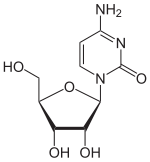Cytidine
 |
|
 |
|
| Names | |
|---|---|
| IUPAC name
4-amino-1-[3,4-dihydroxy-5-(hydroxymethyl)tetrahydrofuran-2-yl]pyrimidin-2-one
|
|
| Identifiers | |
| 65-46-3 |
|
| 3D model (Jmol) | Interactive image |
| ChEBI | CHEBI:17562 |
| ChEMBL | ChEMBL95606 |
| ChemSpider | 5940 |
| ECHA InfoCard | 100.000.555 |
| 4728 | |
| KEGG | D07769 |
| MeSH | Cytidine |
| PubChem | 6175 |
| UNII | 5CSZ8459RP |
|
|
|
|
| Properties | |
| C9H13N3O5 | |
| Molar mass | 243.217 |
| -123.7·10−6 cm3/mol | |
|
Except where otherwise noted, data are given for materials in their standard state (at 25 °C [77 °F], 100 kPa).
|
|
| Infobox references | |
Cytidine is a nucleoside molecule that is formed when cytosine is attached to a ribose ring (also known as a ribofuranose) via a β-N1-glycosidic bond. Cytidine is a component of RNA.
If cytosine is attached to a deoxyribose ring, it is known as a deoxycytidine.
Contents
Dietary sources of cytidine[edit]
Dietary sources of cytidine include foods with high RNA (ribonucleic acid) content,[1] such as organ meats, Brewer's yeast, as well as pyrimidine-rich foods such as beer. During digestion, RNA-rich foods are broken-down into ribosyl pyrimidines (cytidine and uridine), which are absorbed intact.[1] In humans, dietary cytidine is converted into uridine,[2] which is probably the compound behind cytidine's metabolic effects.
Cytidine analogues[edit]
There are a variety of cytidine analogues with potentially useful pharmacology. For example, KP-1461 is an anti-HIV agent that works as a viral mutagen,[3] and zebularine exists in E. coli and is being examined for chemotherapy. Low doses of azacitidine and its analog decitabine have shown results against cancer through epigenetic demethylation.[4]
Biological actions[edit]
In addition to its role as a pyrimidine component of RNA, cytidine has been found to control neuronal-glial glutamate cycling, with supplementation decreasing midfrontal/cerebral glutamate/glutamine levels.[5] As such, cytidine has generated interest as a potential glutamatergic antidepressant drug.[5]
References[edit]
- ^ a b Jonas DA; Elmadfa I; Engel KH; et al. (2001). "Safety considerations of DNA in food". Ann Nutr Metab. 45 (6): 235–54. doi:10.1159/000046734. PMID 11786646.
- ^ Wurtman RJ, Regan M, Ulus I, Yu L (Oct 2000). "Effect of oral CDP-choline on plasma choline and uridine levels in humans". Biochem Pharmacol. 60 (7): 989–92. doi:10.1016/S0006-2952(00)00436-6. PMID 10974208.
- ^ John S. James. "New Kind of Antiretroviral, KP-1461". AIDS Treatment News.
- ^ "Scientists reprogram cancer cells with low doses of epigenetic drugs". Medical XPress. March 22, 2012.
- ^ a b Machado-Vieira, Rodrigo; Salvadore, Giacomo; DiazGranados, Nancy; Ibrahim, Lobna; Latov, David; Wheeler-Castillo, Cristina; Baumann, Jacqueline; Henter, Ioline D.; Zarate, Carlos A. (2010). "New Therapeutic Targets for Mood Disorders". The Scientific World JOURNAL. 10: 713–726. doi:10.1100/tsw.2010.65. ISSN 1537-744X.